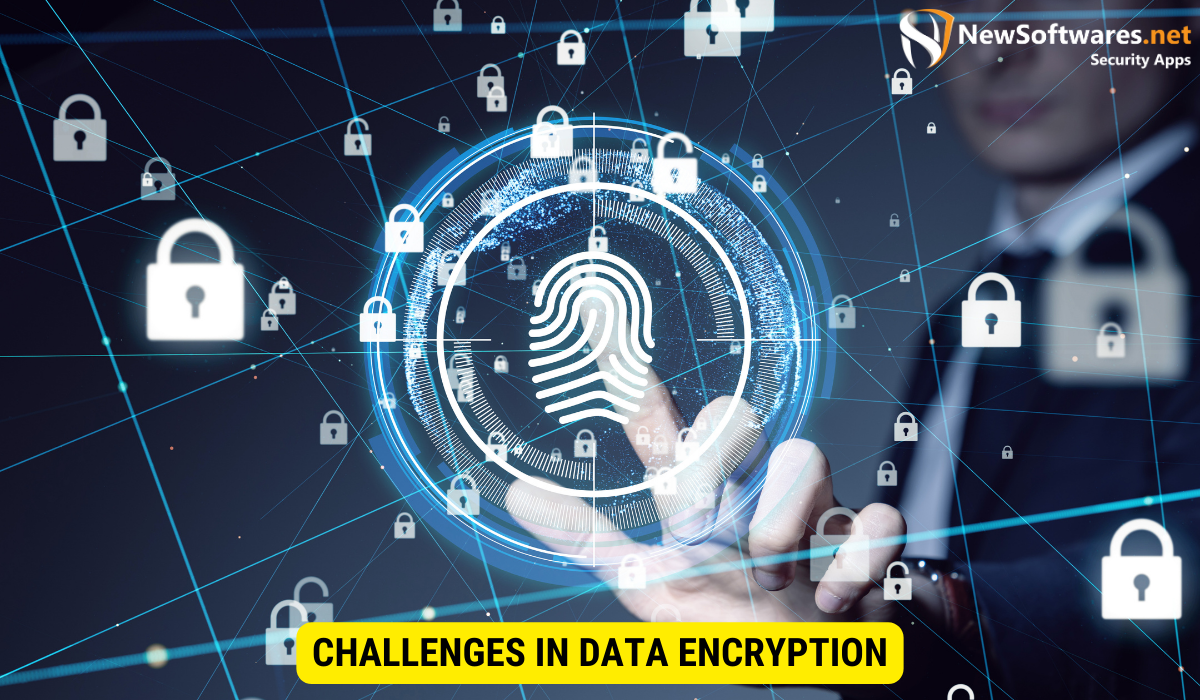Data encryption converts plain text into encoded data, known as ciphertext, to prevent unauthorized access and ensure confidentiality.
In today’s digitally connected world, data security has become a top priority for large corporations. With the increasing volume of data being transmitted over the Internet, organizations must implement robust encryption strategies to protect sensitive information from unauthorized access or interception by malicious actors. Together, we will explores the various data encryption strategies large corporations employ to secure data for travel over the Internet.
Understanding Data Encryption

Data encryption converts plain text into encoded data, ciphertext, to prevent unauthorized access and ensure confidentiality. It involves using cryptographic algorithms and keys to scramble the data so that it can only be decrypted and understood by the intended recipient. Encryption is crucial in safeguarding sensitive data from unauthorized access and maintaining data integrity.
The Importance of Data Encryption in Corporations
In large corporations, the importance of data encryption cannot be overstated. The risks associated with information breaches and unauthorized access can have severe consequences, leading to financial loss, damage to reputation, and potential legal implications. By encrypting sensitive data, corporations can mitigate these risks and ensure that even if data falls into the wrong hands, it remains inaccessible and unreadable.
Basic Concepts and Terminology in Data Encryption
Before delving into different encryption techniques, it is essential to understand some fundamental concepts and terminology associated with data encryption. These include:
- Plaintext: The original, unencrypted form of the data.
- Ciphertext: The encrypted form of the data.
- Encryption algorithm: A mathematical formula used to transform plaintext into ciphertext.
- Key: A secret value used with the encryption algorithm to encrypt and decrypt data.
- Encryption strength: The level of security provided by an encryption algorithm.
Data encryption has a long history that dates back to ancient times. The concept of encryption can be traced back to the time of Julius Caesar, who used a substitution cipher to protect his military communications. Over the centuries, encryption techniques have evolved significantly with the development of more complex algorithms and advanced computing systems.
One of the earliest encryption methods, the Caesar cipher, involved shifting each alphabet letter by a certain number of positions. For example, if the shift was in three positions, the letter ‘A’ would be encrypted as ‘D,’ ‘B’ as ‘E’, and so on. While this method provided a basic level of security, it was relatively easy to decipher through frequency analysis.
As technology advanced, encryption techniques became more sophisticated. In the 20th century, the development of electromechanical machines, such as the Enigma machine used during World War II, revolutionized encryption. These machines used complex rotor systems to encrypt messages, making them significantly more secure than previous methods.
With the advent of computers, encryption algorithms became even more complex and robust. Modern encryption algorithms, such as the Advanced Encryption Standard (AES), use complex mathematical operations and large key sizes to provide a high level of security. AES, for example, uses a block cipher with key sizes of 128, 192, or 256 bits, making it highly resistant to brute-force attacks.
Encryption strength is a critical factor in determining the level of security provided by an encryption algorithm. The strength of an encryption algorithm is calculated by the size of the key used and the complexity of the algorithm itself. A longer key length and a more complex algorithm generally result in higher security.
It is important to note that encryption alone is not sufficient to protect data. Proper key management and secure storage of encryption keys are equally important. If encryption keys are compromised, the encrypted data can be decrypted, rendering the encryption useless. Therefore, organizations must implement robust key management practices to ensure the security of their encrypted data.
In conclusion, data encryption is a significant component of modern information security. It provides a means to protect sensitive data from unauthorized access and maintain data integrity. Understanding the basic concept and terminology associated with data encryption is essential for implementing effective encryption strategies and ensuring the security of sensitive information.
Types of Data Encryption Techniques
Large corporations use several data encryption techniques to protect their data. These techniques can be classified into three main categories: symmetric encryption, asymmetric encryption, and hash functions.
Symmetric Encryption
Symmetric encryption, also known as secret-key encryption, involves using a single key for both the encryption and decryption. The same key is used to scramble and unscramble the data, making it faster and more efficient than other encryption techniques. However, the main challenge with symmetric encryption is securely sharing the key among the sender and the recipient.
Asymmetric Encryption
Asymmetric encryption, also identified as public-key encryption, uses a couple of mathematically related keys: public and private keys. The public key is used to encrypt the data, while the private key is used to decrypt it. Asymmetric encryption eliminates the key distribution problem of symmetric encryption, as public key can be freely shared while keeping the private key secure.
Hash Functions
Hash functions are cryptographic algorithms that convert input data of arbitrary size into a fixed-size output, known as a hash value or digest. Unlike encryption, hash functions are one-way operations and cannot be reversed to obtain the original data. Hash functions are usually used to verify data integrity and ensure that data has not been tampered with during transmission.
How Corporations Implement Data Encryption?
Large corporations employ various techniques and tools to implement data encryption effectively. These include encryption software and tools and encryption policies and procedures.
Encryption Software and Tools
A wide range of encryption software and tools are available in the market that corporations can utilize to implement data encryption. These tools give a user-friendly interface and allow organizations to encrypt data at rest, in transit, or both. Examples of popular encryption software and tools include BitLocker, VeraCrypt, and OpenSSL.
Encryption Policies and Procedures
Corporations also establish encryption policies and procedures to ensure consistent and secure use of encryption within the organization. These policies outline the encryption requirements for various types of data and specify the encryption algorithms, key lengths, and other security parameters to be used. Standard training and awareness programs are conducted to educate employees about encryption best practices and to make sure compliance with the established policies and procedures.
Securing Data for Travel Over the Internet
When it comes to securing data for travel over the Internet, several technologies and protocols are commonly used by large corporations.
Secure Sockets Layer (SSL) & (TLS) Transport Layer Security
SSL and its successor, TLS, are cryptographic protocols for securing internet communications. These protocols set up an encrypted link between the web server and the client, ensuring that data transmitted over the Internet remains secret and protected from eavesdropping. SSL and TLS are usually used to secure sensitive transactions like online banking, e-commerce, and email.
Internet Protocol Security (IPSec)
IPSec is a protocol suite to secure IP communications at the network layer. It provides authentication, integrity, and confidentiality services for IP packets, ensuring secure communication between network devices. IPSec is used to establish virtual private networks (VPNs) and secure remote access connections.
Virtual Private Networks (VPNs)
VPNs create an encrypted tunnel connecting the user’s device and the corporate network, allowing secure and private communication over the Internet. By routing all traffic through the VPN tunnel, corporations can ensure the confidentiality and integrity of data transmitted over public networks. Remote employees and business travelers commonly use VPNs to connect securely to their corporate networks.
Challenges in Data Encryption

While data encryption is vital for securing sensitive information, it also poses certain challenges that corporations must address.
Key Management Issues
One of the key challenges in data encryption is key management. With the increasing volume of encrypted data, securely storing and managing encryption keys becomes complex. Corporations must implement robust key management policies and procedures to ensure the secure generation, storage, and disposal of encryption keys.
Performance Overhead
Data encryption and decryption require computational resources, which can impose a performance overhead on systems, especially when dealing with large volumes of data. Corporations need to balance security and performance to ensure that encryption does not impede the efficiency of critical business processes.
Compliance and Legal Considerations
Corporations operating in regulated industries or dealing with sensitive data must comply with various legal and regulatory requirements governing data protection and privacy. Encryption often plays a significant role in meeting these compliance obligations. Organizations must understand the specific requirements and implement encryption solutions that align with the applicable regulations.
Key Takeaways
- Data encryption is vital for large corporations to secure sensitive information from unauthorized access and maintain data integrity.
- Corporations use encryption techniques, including symmetric encryption, asymmetric encryption, and hash functions, to protect data.
- Encryption software and tools, along with comprehensive policies and procedures, are employed to implement data encryption effectively within organizations.
- Secure protocols such as SSL/TLS, IPSec, and VPNs are commonly used to secure data transmission over the Internet.
- When implementing data encryption strategies, corporations face challenges in key management, performance overhead, and compliance.
FAQs
What is data encryption?
Data encryption converts plain text into encoded data, known as ciphertext, to prevent unauthorized access and ensure confidentiality.
Why is data encryption important for corporations?
Data encryption is essential for corporations as it mitigates the risks associated with data breaches, protects sensitive information, and ensures compliance with regulatory requirements.
What are the types of data encryption techniques used by corporations?
Corporations use symmetric, asymmetric, and hash functions to protect their data.
How do corporations implement data encryption?
Corporations implement data encryption through the use of encryption software and tools, along with the establishment of encryption policies and procedures.
What challenges do corporations face in data encryption?
When implementing data encryption strategies, corporations face challenges in key management, performance overhead, and compliance.
Conclusion
Data encryption is a serious component of a complete cybersecurity strategy for large corporations. It provides the necessary protection for sensitive data during transmission over the Internet and helps mitigate the risks associated with unauthorized access. By understanding the different encryption techniques, implementing robust encryption policies and procedures, and leveraging secure protocols and technologies, corporations can ensure the security and integrity of their data. While encryption is not foolproof, it significantly enhances data security and helps organizations maintain the trust and confidence of their stakeholders.
